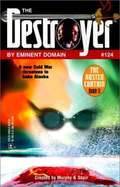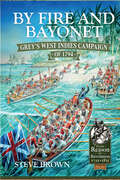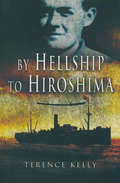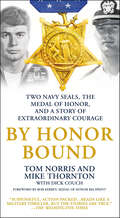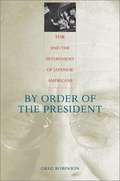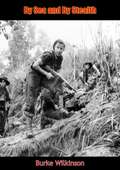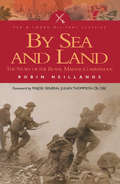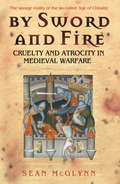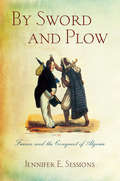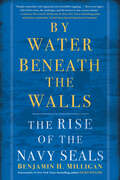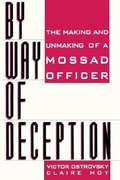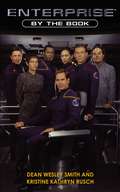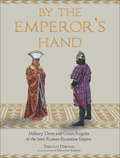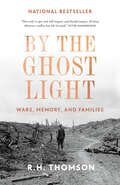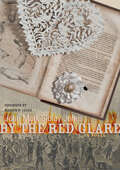- Table View
- List View
By Eastern Windows: The Story of a Battle of Souls and Minds in the Prison Camps of Sumatra
by William H. McDougall Jr.First published in 1949, in By Eastern Windows author William H. McDougall recalls his experiences of his three years spent in prison camps in Sumatra.“By Eastern Windows is filled with stories of the heroism and sacrifice of priests, doctors and simple men, as well as of the disgraceful behaviour of deadbeats and chiselers. It is written throughout in a spirit of humility and humble faith. It packs a wallop…”—Orville Prescott, New York Times“…By Eastern Windows…is a book that deals with the spirit of mankind at war and is directed to the spirit of mankind in peace. Everyone who reads this book upon completion surely must agree with the author that ‘there is no possible disarmament except in the hearts of men.’”—Grace S. Nutley, New York Eagle“…It is an amazing tale with humor lighting tragedy and heroism marking what might have been the sheerest of animal existences. By Eastern Windows is perhaps the best book of its sort to date in that it is neither so objectively done that it misses the ever-present human element, nor so sentimentally reported that it fails to show both sides of the Japanese captors as they went somewhat bewilderedly about their tasks in a losing fight.”—T.M.W., Boston Traveler
By Emminent Domain (Destroyer #124)
by Warren Murphy Richard SapirWhen advanced Russian comandos go on a rampage in Alaska, it is time for Remo and the master of Sinanju to put a hault to their ambitions of soviet rebirth and expanse.
By Fire Above: A Signal Airship Novel (The Signal Airship Novels #2)
by Robyn BennisBy Fire Above is the rip-roaring new adventure in Robyn Bennis's Signal Airship military fantasy series that Patricia Briggs hails as &“full of sass and terrific characters.&” "All's fair in love and war," according to airship captain Josette Dupre, until her hometown of Durum becomes occupied by the enemy and her mother a prisoner of war. Then it becomes, "Nothing's fair except bombing those Vins to high hell." Before she can rescue her town, however, Josette must maneuver her way through the nest of overstuffed vipers that make up Garnia's military and royal leaders in order to drum up support. The foppish and mostly tolerated Mistral crew member Lord Bernat steps in to advise her, along with his very attractive older brother. Between noble scheming, under-trained recruits, and supply shortages, Josette and the crew of the Mistral figure out a way to return to Durum—only to discover that when the homefront turns into the frontlines, things are more dangerous than they seem. &“Full of sass and terrific characters. Great storytelling. Loved it.&” —Patricia Briggs &“Marvelous, witty and action-packed steampunk with exquisite attention to detail. Bennis's writing is incredible, her vocabulary impressive, and she honest to God made me believe you could build an airship from spare parts.&” —Ann Aguirre, New York Times and USA Today–bestselling author
By Fire and Bayonet: Grey's West Indies Campaign of 1794 (From Reason to Revolution)
by Steve BrownThere have been few books about Grey's glorious (but ultimately ill-fated) West Indies campaign in the early years of the long and terrible wars of 1793-1815, yet five of the subalterns in Grey's expeditionary force went on to command divisions in Wellington's Peninsula army; another two commanded the Iron Duke's Royal Artillery; and one (Richard Fletcher) - famously - the Royal Engineers. The tactics used by Sir Charles Grey were as far removed as can be imagined from the traditional image of the two-deep British line delivering massed volleys at pointblank range. The invasions of Martinique, St Lucia and Guadeloupe were raids undertaken by Special Forces, who were instructed to operate in open order, in silence and at bayonet-point; all attacks went in with unloaded muskets. Most of the heavy-duty fighting was undertaken by converged flank battalions, grenadiers and light infantrymen - assembled under hand-picked field officers and used as stormtroopers in every major assault; here were French revolutionary war tactics that are largely unexplored and largely undocumented (at least in modern times). Sir Charles Grey was one of the most aggressive British generals of the era - something his gentlemanly appearance and demeanor did not immediately indicate. Ever cheerful and optimistic - and humane and loyal to his friends - his ability to deliver needle-sharp assaults and then harry a defeated enemy (the latter being something at which British generals of the Napoleonic era were distinctly mediocre) makes him one of the more interesting personalities of the early portion of the 'Great War with France'. If he was not ultimately unsuccessful, it was not his fault: he was robbed of the resources he needed at the outset; then given virtually no reinforcements by Horse Guards. The great killer on this campaign was not the French... it was disease: principally, Yellow Fever. Of the 6,200 men who landed with Grey on Martinique in February 1794, some 4,100 were dead by Christmas - such then is By Fire and Bayonet an account of a very dramatic period for the British Army in the West Indies. It took many years to learn the lessons presented by the campaign, but for the young officers who survived, it provided some invaluable lessons that were put to good use 15 or 20 years later in the British Army of a later era.
By Fire and Ice: Dismantling Chemical Weapons While Preserving the Environment (Routledge Library Editions: Cold War Security Studies #9)
by David A. KoplowThis book, first published in 1997, examines the forced merger between national security interests and environmental policy makers arising from the Chemical Weapons Convention and its requirement to safely dismantle the world’s chemical weapons stockpiles. The two groups had to find a way to intersect and work together, and this book analyses the problems and politics involved.
By Hellship to Hiroshima
by Terence KellyTaken prisoner in Java, Terence Kellys captivity was full of incident. He was witness to barbaric cruelty and suffering particularly on the journey packed into a filthy cargo ship under atrocious and inhumane conditions.Once in Japan, he was a slave in the Hitachi shipyards where he got to know other Japanese and learn their language. His book reveals more about the psyche of his captors than other similar works. His Hiroshima camp was unique and was possibly the best camp in which the Japs held POWs. Many of the inmates were influential men, who knew the Far East and had held important posts. The interaction between POWs and captors was fascinating and his book offers a rare insight into the Japanese character, as unthinkable defeat and humiliation became a reality.Kellys account of the A-Bomb attack and the chaos that followed it is fascinating and rare.
By Honor Bound: Two Navy SEALs, the Medal of Honor, and a Story of Extraordinary Courage
by Dick Couch Mike Thornton Tom NorrisBy Honor Bound is the powerful and moving story of two Medal of Honor recipients, written by New York Times bestselling author Dick Couch.“Delivers cracking-good minute-by-minute descriptions of two SEAL missions rich in suspense, with technically accurate fireworks and undeniable heroism.” —HistoryNetIn April of 1972, near the end of the Vietnam War, SEAL Lieutenant Tom Norris performed an unprecedented ground rescue of two American airmen who were shot down behind enemy lines in North Vietnam, a feat for which he would be awarded the Medal of Honor. Just six months later, Norris was sent on a dangerous special reconnaissance mission that would take his team deep into enemy territory. In the running gun battle that ensued, Lieutenant Norris was severely wounded; a bullet entered his left eye and exited the left side of his head. SEAL Petty Officer Mike Thornton, under heavy fire, fought his way back onto a North Vietnamese beach to rescue his officer—an act of heroism that earned him the Medal of Honor as well.This is the true story of two living American legends who entered military service and the Navy SEAL teams for vastly different reasons—and were thrown together for a single combat mission that would define their lives.
By Motor To The Firing Line: An Artist’s Notes And Sketches With The Armies Of Northern France: June-July, 1915 [Illustrated Edition]
by Walter Hale[Illustrated with 47 paintings and photos]Walter Hale was a man of many talents - actor, writer, artist and war correspondent - before his life was cut short by cancer in 1917. It is fitting, however, that he was able to visit the front lines of the Western Front during the First World War, for the sights and stories that he recorded with pen, camera and paintbrush were well worth recording. That he was in the right time and place he put down to good luck; however, it seems only fair to record that he seems to have made his own luck on what would be a hard driven tour of the beleaguered front. As the author confirms in his introduction, his work is not a military history, but a portrait of the people, places, buildings and landscapes of Northern France and the effect of war on them.
By Order of the President (Presidential Agent Ser. #No. 1)
by W.E.B. GriffinWhen a leased Boeing 727 is violently hijacked from Angola and flown to parts unknown, the President turns to an outsider--Major Carlos Guillermo Castillo--for answers. A pilot, West Point graduate, and veteran of Desert Storm, Castillo has a sharp eye for the facts--and the truth behind them. In Africa, he is helped and hindered by unexpected allies and ruthless enemies, and begins to untangle a plot of horrific dimensions--a plot that, unless Castillo acts quickly, will end very, very badly.
By Order of the President: FDR and the Internment of Japanese Americans
by Greg RobinsonAs a student at Harvard, FDR knew a Japanese student who often discussed his nation's military ambitions. From his youth, FDR had a complex blend of admiration for and fear of Japan. For several years before Pearl Harbor he ordered secret investigations of the Japanese American community. Though all reports assured him that the Japanese living in the United States did not pose a threat, Roosevelt responded to public pressure at the outbreak of the war. This book examines his personality and history as they relate to his decision to intern the Japanese Americans and his attitudes toward the internment as the war progressed. The picture which emerges is a sharp contrast to commonly accepted images of Roosevelt as a president who championed minorities and the poor.
By Sea and By Stealth
by Burke WilkinsonOne night in December 1941 a young Italian sat shivering on a buoy in Alexandria Harbour. Four hours later two British battleships blew up and settled on the muddy bottom. Luigi De La Penne had successfully completed one of the most fantastic surprise attacks of the war.This and many other extraordinary attacks showed great resourcefulness, courage and daring. The cost in lives and material was small, the stakes dazzlingly high.First published in 1957, this book from American novelist Burke Wilkinson tells of some of the most striking and brilliant surprise attacks made by sea during the war. The individual exploits carry their own compulsion as tales of great courage and daring always do, but more than that they show the valuable lessons to be learned and the future hazards we must face from these bold and venturesome tactics.
By Sea and Land: The Story of the Royal Marine Commandos (Cassell Military Paperbacks Ser.)
by Robin NeillandsThis is the story of a fighting force. In the words of the marines themselves, Robin Neillands, formerly of 45 Commando RM, describes what it is really like to wear the legendary green beret, in peace and in war. This vivid account charts the story of the Royal Marine Commandos from their bloody baptism on the beaches of Dieppe to the final yomp into Stanley at the end of the Falklands War in 1982.
By Sword and Fire: Cruelty And Atrocity In Medieval Warfare
by Sean McGlynnA vivid and original account of warfare in the Middle Ages and the cruelty and atrocity that accompanied it.Sean McGlynn investigates the reality of medieval warfare. For all the talk of chivalry, medieval warfare routinely involved acts which we would consider war crimes. Lands laid waste, civilians slaughtered, prisoners massacred: this was standard fare justified by tradition and practical military necessity. It was unbelievably barbaric, but seldom uncontrolled. Such acts of atrocity were calculated, hideous cruelties inflicted in order to achieve a specific end. Sean McGlynn examines the battles of Acre and Agincourt, sieges like Béziers, Lincoln, Jerusalem and Limoges as well as the infamous chevauchées of the Hundred Years War that devastated great swathes of France. He reveals how these grisly affairs form the origin of accepted 'rules of war', codes of conduct that are today being enforced in the International Court of Justice in the Hague.
By Sword and Fire: Cruelty And Atrocity In Medieval Warfare
by Sean McglynnSean McGlynn investigates the reality of medieval warfare. For all the talk of chivalry, medieval warfare routinely involved acts which we would consider war crimes. Lands laid waste, civilians slaughtered, prisoners massacred: this was standard fare justified by tradition and practical military necessity. It was unbelievably barbaric, but seldom uncontrolled.Such acts of atrocity were calculated, hideous cruelties inflicted in order to achieve a specific end. Sean McGlynn examines the battles of Acre and Agincourt, sieges like Béziers, Lincoln, Jerusalem and Limoges as well as the infamous chevauchées of the Hundred Years War that devastated great swathes of France. He reveals how these grisly affairs form the origin of accepted ¿rules of war¿, codes of conduct that are today being enforced in the International Court of Justice in the Hague.
By Sword and Plow: France and the Conquest of Algeria
by Jennifer E. SessionsIn 1830, with France's colonial empire in ruins, Charles X ordered his army to invade Ottoman Algiers. Victory did not salvage his regime from revolution, but it began the French conquest of Algeria, which was continued and consolidated by the succeeding July Monarchy. In By Sword and Plow, Jennifer E. Sessions explains why France chose first to conquer Algeria and then to transform it into its only large-scale settler colony. Deftly reconstructing the political culture of mid-nineteenth-century France, she also sheds light on policies whose long-term consequences remain a source of social, cultural, and political tensions in France and its former colony. In Sessions's view, French expansion in North Africa was rooted in contests over sovereignty and male citizenship in the wake of the Atlantic revolutions of the eighteenth century. The French monarchy embraced warfare as a means to legitimize new forms of rule, incorporating the Algerian army into royal iconography and public festivals. Colorful broadsides, songs, and plays depicted the men of the Armée d'Afrique as citizen soldiers. Social reformers and colonial theorists formulated plans to settle Algeria with European emigrants. The propaganda used to recruit settlers featured imagery celebrating Algeria's agricultural potential, but the male emigrants who responded were primarily poor, urban laborers who saw the colony as a place to exercise what they saw as their right to work. Generously illustrated with examples of this imperialist iconography, Sessions's work connects a wide-ranging culture of empire to specific policies of colonization during a pivotal period in the genesis of modern France.
By Tank into Normandy
by Stuart HillsStuart Hills embarked his Sherman DD tank on to an LCT at 6.45 a.m., Sunday 4 June 1944. He was 20 years old, unblooded, fresh from a public-school background and Officer Cadet training. He was going to war. Two days later, his tank sunk, he and his crew landed from a rubber dinghy with just the clothes they stood in. After that, the struggles through the Normandy bocage in a replacement tank (of the non-swimming variety), engaging the enemy in a constant round of close encounters, led to a swift mastering of the art of tank warfare and remarkable survival in the midst of carnage and destruction. His story of that journey through hell to victory makes for compulsive reading.
By Tank into Normandy
by Stuart Hills'One of the best half-dozen personal accounts of the Normandy campaign' - Richard HolmesStuart Hills embarked his Sherman DD tank on to an LCT at 6.45 a.m., Sunday 4 June 1944. He was 20 years old, unblooded, fresh from a public-school background and Officer Cadet training. He was going to war. Two days later, his tank sunk, he and his crew landed from a rubber dinghy with just the clothes they stood in. After that, the struggles through the Normandy bocage in a replacement tank (of the non-swimming variety), engaging the enemy in a constant round of close encounters, led to a swift mastering of the art of tank warfare and remarkable survival in the midst of carnage and destruction. His story of that journey through hell to victory makes for compulsive reading.
By Trust Betrayed: Patients, Physicians, and the License to Kill in the Third Reich
by Hugh G. GallagherIn September of 1939, immediately after he started World War II by sending an invading army into Poland, Adolf Hitler signed an order declaring war on his fellow German citizens-- that is, those of his fellow citizens who were crippled, mentally ill, or disabled. The directive was given to two of Hitler's closest associates, Dr. Karl Brandt, his personal physician, and Reichsleiter Philip Bouhler, the chief of his chancellery. They were to set up a program that enabled German physicians to kill anyone deemed "unworthy of life." Under the influence of the then-fashionable apocalyptic theories of eugenics, many German doctors greeted this blood-chilling idea as a "technological breakthrough" and an example of the new regime's advanced thinking, while the majority simply accepted it without protest. Despite this acceptance, and a barrage of propaganda in books, movies, newspapers, and magazines attempting to justify euthanasia, public outrage began to grow. Because of the resistance of brave disabled people and because of the public sermons of important clergy, including Clemens von Galen, the Bishop of Munster, Hitler rescinded his official order, suffering the only major policy reversal of his twelve years in power. Despite the absence of an official order, however, the doctors who had been authorized to kill continued to do so without any fear of reprisal or prosecution. More than 200,000 people were killed under the program throughout the war and even, in some cases, during the occupation that followed the war.
By Water Beneath the Walls: The Rise of the Navy SEALs
by Benjamin H. MilliganA gripping history chronicling the fits and starts of American special operations and the ultimate rise of the Navy SEALs from unarmed frogmen to elite, go-anywhere commandos—as told by one of their own.&“Deeply researched, well organized, and incredibly engaging . . . This is our legacy with all the warts, the challenges, and the heroics in one concise volume.&”—Admiral William H. McRaven, #1 New York Times bestselling author and former commander, United States Special Operations CommandHow did the US Navy—the branch of the US military tasked with patrolling the oceans—ever manage to produce a unit of raiders trained to operate on land? And how, against all odds, did that unit become one of the world&’s most elite commando forces, routinely striking thousands of miles from the water on the battlefields of Iraq, Afghanistan, Syria, even Central Africa?Behind the SEALs&’ improbable rise lies the most remarkable underdog story in American military history—and in these pages, former Navy SEAL Benjamin H. Milligan captures it as never before.Told through the eyes of remarkable leaders and racing from one longshot, hair-curling raid to the next, By Water Beneath the Walls is the tale of the unit&’s heroic naval predecessors, and the evolution of the SEALs themselves. But it&’s also the story of the forging of American special operations as a whole—and how the SEALs emerged from the fires as America&’s first permanent commando force when again and again some other unit seemed predestined to seize that role. Here Milligan thrillingly captures the outsize feats of the SEALs&’ frogmen forefathers in World War II, the Korean War, and elsewhere, even as he plunges us into the second front of interservice rivalries and personal ambition that shaped the SEALs&’ evolution.In equally vivid, masterful detail, he chronicles key early missions undertaken by units like the Marine Raiders, Army Rangers, and Green Berets, showing us how these fateful, bloody moments helped create the modern American commando—even as they opened up pivotal opportunities for the Navy.Finally, he takes us alongside as the SEALs at last seize the mantle of commando raiding, and discover the missions of capture/kill and counterterrorism that would define them for decades to come.Now required reading throughout the US special operations community, By Water Beneath the Walls is an essential history of the SEAL teams, a crackling account of desperate last stands and unforgettable characters accomplishing the impossible—and a riveting epic of the dawn of American special operations.
By Way Of Deception: The Making And Unmaking Of A Mossad Officer
by Victor Ostrovsky Claire HoyThe first time the Mossad came calling, they wanted Victor Ostrovsky for their assassination unit, the kidon. He turned them down. The next time, he agreed to enter the grueling three-year training program to become a katsa, or intelligence case officer, for the legendary Israeli spy organization. By Way of Deception is the explosive chronicle of his experiences in the Mossad, and of two decades of their frightening and often ruthless covert activities around the world. Penetrating far deeper than the bestselling Every Spy a Prince, it is an insider's account of Mossad tactics and exploits. <p><p> In chilling detail, Ostrovsky asserts that the Mossad refused to share critical knowledge of a planned suicide mission in Beirut, leading to the death of hundreds of U.S. Marines and French troops. He tells how they tracked Yasser Arafat by recruiting his driver and bodyguard; how they withheld information on the whereabouts of American hostages, paving the way for the Iran-Contra scandal; and how their intervention into secret UN negotiations led to the sudden resignation of ambassador Andrew Young and the downfall of his career. <p> By Way of Deception describes the shocking scope and depth of the Mossad's influence, disclosing how Jewish communities in the U.S., Europe, and South America are armed and trained by the organization in secret "self-defense" units, and how Mossad agents facilitate the drug trade in order to pay the enormous costs of its far-flung, clandestine operation. And it portrays a network that has grown dangerously out of control, as internal squabbles have led to the escape of terrorists and the pursuit of "policies" completely at odds with the interests of the state of Israel. This document is possibly the most important and controversial book of its kind since Spycatcher.
By the Book (Star Trek: Enterprise)
by Kristine Kathryn Rusch Dean Wesley SmithIn their first few weeks in space, Captain Jonathan Archer and the crew of the Enterprise have already discovered several new species and explored strange new worlds. But each planet brings new discoveries...and new dangers. BY THE BOOK The Fazi, whose ultraregulated culture ranges from strict conversation protocols to unvarying building designs, inhabit half of a planet discovered by the Enterprise. But after a disasterous first contact with the ruler of the Fazi, Archer must depend on Vulcan science officer T'Pol and communication specialist Hoshi Sato to help him mend relations with the people of this planet, and unravel the mystery of the other creatures living on the world.
By the Emperor's Hand: Military Dress and Court Regalia in the Later Romano-Byzantine Empire
by Timothy DawsonAs absolute as Hitler's control over the German war machine was, it depended on the ability, judgment and unquestioning loyalty of the senior officers charged with putting his ideas, however difficult, into effect.Top military historian James Lucas examines the stories of fourteen of these men: all of different rank, from varied backgrounds, and highly awarded, they exemplify German military prowess at its most dangerous. Among his subjects are Eduard Dietl, the commander of German forces in Norway and Eastern Europe; Werner Kampf, one of the most successful Panzer commanders of the war; and Kurt Meyer, commander of the Hitler Youth Division and one of Germany's youngest general officers.The author, one of the leading experts on all aspects of German military conduct of the Second World War, offers the reader a rare look into the nature of the German Army a curious mix of individual strength, petty officialdom and pragmatic action.
By the Ghost Light: Wars, Memory, and Families
by R.H. ThomsonFrom one of Canada&’s most beloved performing artists comes an audacious work of non-fiction that explores the stories that shape us and the reach that the past can have across generations.Growing up north of Toronto, R.H. Thomson&’s imagination was captured by romantic notions of war. He spent his days playing with toy soldiers on the carpet of his grandmother&’s house, recreating the Battle of Britain with model planes in his bedroom, or sitting at the local theatre watching World War II B movies—ones that offered a very clear perspective on who were the heroes and who the villains; which side were the victors and which the vanquished. Yet Thomson&’s childhood was also shaped by the spirits of real-life warriors in his family, their fates a brutal and more complicated reminder of the true human cost of war. Eight of Robert&’s great uncles—George, Joe, Jack, Harold, Arthur, Warren, Wildy, and Fred—fought in the First World War, while his great Aunt Margaret served as a wartime surgical nurse in Europe. Five of the great uncles—George, Joe, Fred, Wildy, and Warren—were killed in battle while two others—Jack and Harold—would return home greatly diminished, spending the rest of their lives in and out of sanitariums, their lungs scarred by disease and poison gas. Throughout their lives, the great uncles, as well as great aunts and cousins, were faithful letter writers, their correspondence offering profound insights into their experiences on the front lines to their loved ones back home, a somber record of the sacrifice the family paid. In By the Ghost Light, R.H. Thomson offers an extraordinary look at his family&’s history while providing a powerful examination of how we understand war and its aftermath. Using his family letters as a starting point, Thomson roams through a century of folly, touching on areas of military history, art, literature, and science, to express the tragic human cost of war behind the order and calm of ceremonial parades, memorials, and monuments. In an urgent call for new ways to acknowledge the dead, R.H. has created &“The World Remembers,&” an ambitious international project to individually name each of the millions killed in the First World War. Epic in its scope and incredibly intimate in its exploration of lives touched by the tragedy of war, By the Ghost Light is a truly original book that will challenge the way we approach our history.
By the Ghost Light: Wars, Memory, and Families
by R.H. ThomsonNATIONAL BESTSELLER • From one of Canada&’s most beloved performing artists comes an audacious work of non-fiction that explores the stories that shape us and the reach that the past can have across generations • "Thomson makes visible the ghosts of the Great War, untangling themes of loss and longing, service, and grief." —Tim CookGrowing up north of Toronto, R.H. Thomson&’s imagination was captured by romantic notions of war. He spent his days playing with toy soldiers on the carpet of his grandmother&’s house, recreating the Battle of Britain with model planes in his bedroom, or sitting at the local theatre watching World War II B movies—ones that offered a very clear perspective on who were the heroes and who the villains; which side were the victors and which the vanquished. Yet Thomson&’s childhood was also shaped by the spirits of real-life warriors in his family, their fates a brutal and more complicated reminder of the true human cost of war. Eight of Robert&’s great uncles—George, Joe, Jack, Harold, Arthur, Warren, Wildy, and Fred—fought in the First World War, while his great Aunt Margaret served as a wartime surgical nurse in Europe. Five of the great uncles—George, Joe, Fred, Wildy, and Warren—were killed in battle while two others—Jack and Harold—would return home greatly diminished, spending the rest of their lives in and out of sanitariums, their lungs scarred by disease and poison gas. Throughout their lives, the great uncles, as well as great aunts and cousins, were faithful letter writers, their correspondence offering profound insights into their experiences on the front lines to their loved ones back home, a somber record of the sacrifice the family paid. In By the Ghost Light, R.H. Thomson offers an extraordinary look at his family&’s history while providing a powerful examination of how we understand war and its aftermath. Using his family letters as a starting point, Thomson roams through a century of folly, touching on areas of military history, art, literature, and science, to express the tragic human cost of war behind the order and calm of ceremonial parades, memorials, and monuments. In an urgent call for new ways to acknowledge the dead, R.H. has created &“The World Remembers,&” an ambitious international project to individually name each of the millions killed in the First World War. Epic in its scope and incredibly intimate in its exploration of lives touched by the tragedy of war, By the Ghost Light is a truly original book that will challenge the way we approach our history.
By the Red Glare: A Novel (Story River Bks.)
by John Mark Sibley-JonesThis sprawling Civil War novel vividly explores the collapse of the Confederacy as General Sherman marches on the South Carolina capital.Fear and brutality grip Columbia, South Carolina, in the winter of 1865 as General William Tecumseh Sherman continues his march to the sea and advances on the capital city where secession began. John Mark Sibley-Jones’s By the Red Glare takes us into the lives of representative citizens—black and white, men and women, Confederates and Unionists, civilians and combatants, freed and shackled, sane and insane—on the eve of historic destruction.The Columbia hospital is overcrowded with wounded soldiers from both sides and old animosities threaten an outbreak of violence in this place of healing. Less than two miles from the hospital stands the Lunatic Asylum, whose yard is occupied by hundreds of prisoners—some of whom are plotting a risky escape. In the heart of the city, Confederate leaders gather with General James Chesnut to plan a battle strategy, only to hear cannon fire announcing the arrival of Sherman’s troops.Foreword by historian Marion B. Lucas, author of Sherman and the Burning of Columbia

